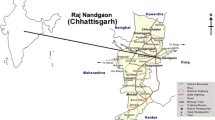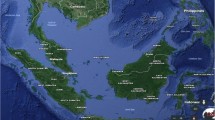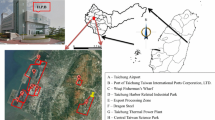Abstract
Several anthropogenic (like industries, vehicles, coal-based thermal power plants, etc.) and natural sources (like lightning, degradation of organic matter, etc.) emit a copious amount of primary gaseous pollutants like Sulphur dioxide (SO2), Nitrogen dioxide (NO2) and Ammonia (NH3), which further contribute in the formation of particulate matters where they are present in the form of water-soluble inorganic ions (WSII) like SO42−, NO3−, NH4+, respectively. To assess the conversion of primary gaseous pollutants into dissolved ions in PM10, real-time sampling (24 h average) of PM10 and primary gaseous pollutants (SO2, NO2, NH3) from September 2021 to March 2022 over 13 highly polluted places in Kolkata were performed. Then PM10 was quantified using the gravimetric method, while NO2 and NH3 were estimated through chemiluminescence and SO2 was estimated through the fluorescent spectrometric method. Analysis of WSII species in PM10 was also performed through the spectrophotometric method and then to understand the conversion of the primary gaseous pollutants into WSIIs in PM10, sulphur oxidation ratio (SOR) and nitrogen oxidation ratio (NOR) and ammonia conversion ratio (NHR) was calculated. The results showed that NO2 is the most abundant primary gaseous pollutant in the ambient air of Kolkata [highest in Dumdum (73.6 μgm−3)] and NO3– is the most abundant WSII in PM10 of Kolkata [highest in Bansdroni (3.74 μgm−3)] and the SOR and NOR values were significantly higher in Bansdroni and NHR was significantly higher in Santoshpur due to presence of optimum meteorological conditions. Lightning is one of the major natural sources of NOx. So, due to lightning, atmospheric NOx level increases which then gets associated with particulate matter, increasing the concentration of NO3− ion in particulate matter due to gas-particle partitioning. This is indicated by strong linear correlation coefficients (R2 = 0.746) between a number of flashes on the day of sampling and NO3− concentration in PM10 aerosol.















Similar content being viewed by others
Availability of data and material
All data generated or analyzed during this study are included in this published article.
Code availability
Not Applicable.
References
Alexander B, Hastings MG, Allman DJ, Dachs J, Thornton JA, Kunasek SA (2009) Quantifying atmospheric nitrate formation pathways based on a global model of the oxygen isotopic composition (Δ17O) of atmospheric nitrate. Atmos Chem Phys 9(14):5043–5056. https://doi.org/10.5194/acp-9-5043-2009
Ansari AS, Pandis SN (1998) Response of inorganic PM to precursor concentrations. Environ Sci Technol 32(18):2706–2714. https://doi.org/10.1021/es971130j
Arimoto R, Duce RA, Savoie DL, Prospero JM, Talbot R, Cullen JD, Tomza U, Lewis NF, Ray BJ (1996) Relationships among aerosol constituents from Asia and the North Pacific during PEM-West A. J Geophys Res: Atmos 101(D1):2011–2023. https://doi.org/10.1029/95JD01071
Aydın H, İlkılıç C (2017) Air pollution, pollutant emissions and harmfull effects. J Eng Technol 1(1):8–15
Baek BH, Aneja VP, Tong Q (2004) Chemical coupling between ammonia, acid gases, and fine particles. Environ Pollut 129(1):89–98. https://doi.org/10.1016/j.envpol.2003.09.022
Bauer SE, Koch D, Unger N, Metzger SM, Shindell DT, Streets DG (2007) Nitrate aerosols today and in 2030: a global simulation including aerosols and tropospheric ozone. Atmos Chem Phys 7:5043–5059. https://doi.org/10.5194/acp-7-5043-2007
Behera SN, Sharma N (2010) Investigating the potential role of ammonia in ion chemistry of fine particulate matter formation for an urban environment. Sci Total Environ 408:3569–3575. https://doi.org/10.1016/j.scitotenv.2010.04.017
Chang SY, Chou CC, Liu S, Zhang Y (2013) The characteristics of PM25 and its chemical compositions between different prevailing wind patterns in Guangzhou. Aerosol Air Qual Res 13(4):1373–1383. https://doi.org/10.4209/aaqr.2012.09.0253
Chatterjee A, Dutta C, Jana TK, Sen S (2012) Fine mode aerosol chemistry over a tropical urban atmosphere: characterization of ionic and carbonaceous species. J Atmos Chem 69(2):83–100. https://doi.org/10.1007/s10874-012-9231-8
Chaudhuri S, Middey A (2013) Effect of meteorological parameters and environmental pollution on thunderstorm and lightning activity over an urban metropolis of India. Urban Climate 3(2):67–75. https://doi.org/10.1016/j.uclim.2013.03.003
Chowdhuri I, Pal SC, Saha A, Chakrabortty R, Ghosh M, Roy P (2020) Significant decrease of lightning activities during COVID-19 lockdown period over Kolkata megacity in India. Sci Total Environ 747:141321. https://doi.org/10.1016/j.scitotenv.2020.141321
CSIR-NEERI (2019) PM10 and PM2.5 Source apportionment study and development of emission inventory of Twin Cities Kolkata and Howrah of West Bengal. https://www.wbpcb.gov.in/writereaddata/files/SA_Kol-How_Final_Report.pdf. Accessed 15 Apr 2022
Deshmukh DK, Tsai YI, Deb MK, Mkoma SL (2012) Characterization of dicarboxylates and inorganic ions in urban PM10 aerosols in the eastern central India. Aerosol Air Qual Res 12(4):592–607. https://doi.org/10.4209/aaqr.2011.10.0160
Felix JD, Murgulet D (2020) Nitrate isotopic composition of sequential Hurricane Harvey wet deposition: low latitude NOx sources and oxidation chemistry. Atmos Environ 238:117748. https://doi.org/10.1016/j.atmosenv.2020.117748
Gogikar P, Tyagi B, Padhan RR, Mahaling M (2018) Particulate matter assessment using in situ observations from 2009 to 2014 over an industrial region of eastern India. Earth Syst Environ 2(2):305–322. https://doi.org/10.1007/s41748-018-0072-8
Gray HA, Cass GR, Huntzicker JJ, Heyerdahl EK, Rau JA (1986) Characteristics of atmospheric organic and elemental carbon particle concentrations in Los-Angeles. Environ Sci Technol 20:580–589. https://doi.org/10.1021/es00148a006
Gupta AK, Karar K, Srivastava A (2007) Chemical mass balance source apportionment of PM 10 and TSP in residential and industrial sites of an urban region of Kolkata, India. J Hazard Mater 142:279–287. https://doi.org/10.1016/j.jhazmat.2006.08.013
Gupta AK, Karar K, Ayoob S, John K (2008) Spatio-temporal characteristics of gaseous and particulate pollutants in an urban region of Kolkata. India Atmos Res 87(2):103–115. https://doi.org/10.1016/j.atmosres.2007.07.008
Hauglustaine DA, Balkanski Y, Schulz M (2014) A global model simulation of present and future nitrate aerosols and their direct radiative forcing of climate. Atmos Chem Phys 14(20):11031–11063. https://doi.org/10.5194/acp-14-11031-2014
Hazra A (2013) Role of mineral dust, soot, and bacteria in cloud and precipitation formation processes over Indian subcontinent using an atmospheric general circulation model. J Atmos Solar Terr Phys 98:74–85. https://doi.org/10.1016/j.jastp.2013.02.019
Hu G, Zhang Y, Sun J, Zhang L, Shen X, Lin W, Yang Y (2014) Variability, formation and acidity of water-soluble ions in PM2.5 in Beijing based on the semi-continuous observations. Atmos Res 145:1–1. https://doi.org/10.1016/j.atmosres.2014.03.014
Kai Z, Yuesi W, Tianxue W, Yousef M, Frank M (2007) Properties of nitrate, sulfate and ammonium in typical polluted atmospheric aerosols (PM10) in Beijing. Atmos Res 84(1):67–77. https://doi.org/10.1016/j.atmosres.2006.05.004
Kamyotra J, Saha D, Tyagi SK, Sen AK, Srivastava RC, Pathak A (2011) Guidelines for the measurement of ambient air pollutants. Central Pollution Control Board-Ministry of Environment and Forests, Govt of India. Accessed 15 Apr 2022
Kaneyasu N, Yoshikado H, Mizuno T, Sakamoto K, Soufuku M (1999) Chemical forms and sources of extremely high nitrate and chloride in winter aerosol pollution in the Kanto plain of Japan. Atmos Environ 33(11):1745–1756. https://doi.org/10.1016/S1352-2310(98)00396-3
Khoder MI (2002) Atmospheric conversion of sulfur dioxide to particulate sulfate and nitrogen dioxide to particulate nitrate and gaseous nitric acid in an urban area. Chemosphere 49:675–684. https://doi.org/10.1016/S0045-6535(02)00391-0
Kothai P, Saradhi IV, Prathibha P, Hopke PK, Pandit GG, Puranik VD (2008) Source apportionment of coarse and fine particulate matter at Navi Mumbai. India Aerosol Air Qual Res 8(4):423–436. https://doi.org/10.4209/aaqr.2008.07.0027
Kumar P, Yadav S (2016) Seasonal variations in water soluble inorganic ions, OC and EC in PM10 and PM>10 aerosols over Delhi: influence of sources and meteorological factors. Aerosol Air Qual Res 16(5):1165–1178. https://doi.org/10.4209/aaqr.2015.07.0472
Leiva GMA, Toro R, Morales RG, Ríos MA, González MR (2014) A study of water-soluble inorganic ions in size-segregated aerosols in atmospheric pollution episode. Int J Environ Sci Technol 11(2):437–448. https://doi.org/10.1007/s13762-013-0221-4
Li TC, Yuan CS, Huang HC, Lee CL, Wu SP, Tong C (2016) Inter-comparison of seasonal variation, chemical characteristics, and source identification of atmospheric fine particles on both sides of the Taiwan Strait. Sci Rep 6(1):1–6. https://doi.org/10.1038/srep22956
Lodge JP (1988) Methods of air sampling and analysis, 3rd edn. Routledge, New York, p 784. https://doi.org/10.1201/9780203747407
Malm WC, Sisler JF, Huffman D, Eldred RA, Cahill TA (1994) Spatial and seasonal trends in particle concentration and optical extinction in the United States. J Geophys Res: Atmos 99(D1):1347–1370. https://doi.org/10.1029/93JD02916
Meng Z, Seinfeld JH (1994) On the source of the submicrometer droplet mode of urban and regional aerosols. Aerosol Sci Technol 20(3):253–265. https://doi.org/10.1080/02786829408959681
Monn C, Schaeppi G (1993) Concentrations of total suspended particulates, fine particles and their anionic compounds in ambient air and indoor air. Environ Technol 14(9):869–875. https://doi.org/10.1080/09593339309385359
Murray LT (2016) Lightning NOx and impacts on air quality. Curr Pollut Rep 2(2):115–133. https://doi.org/10.1007/s40726-016-0031-7
NASA/Goddard Space Flight Center. (2009) Lightning's 'NOx-ious' Impact On Pollution, Climate. ScienceDaily. www.sciencedaily.com/releases/2009/10/091030100022.htm Retrieved 15 April 2022.
Olenius T, Heitto A, Roldin P, Yli-Juuti T, Duwig C (2021) Modeling of exhaust gas cleaning by acid pollutant conversion to aerosol particles. Fuel 290:120044. https://doi.org/10.1016/j.fuel.2020.120044
Orville RE, Huffines G, Nielsen-Gammon J, Zhang R, Ely B, Steiger S, Phillips S, Allen S, Read W (2001) Enhancement of cloud-to-ground lightning over Houston, Texas. Geophys Res Lett 28(13):2597–2600. https://doi.org/10.1029/2001GL012990
Pawar SD, Meena GS, Jadhav DB (2011) Week day and week end air ion variability at rural station Ramanandnagar (17° 4′N, 74° 25′ e), India. Glob Nest J 13(1):65–73
Richards LW, Anderson JA, Blumenthal DL, Mcdonald JA, Macias ES, Hering SV, Wilson WE (1985) Chemical, aerosol and optical measurements in the plumes of three midwestern coal-fired power plants. Atmos Environ 19(10):1685–1704. https://doi.org/10.1016/0004-6981(85)90221-5
Sarkar M, Das A, Mukhopadhyay S (2021) Assessing the immediate impact of COVID-19 lockdown on the air quality of Kolkata and Howrah, West Bengal, India. Environ Dev Sustain 23(6):8613–8642. https://doi.org/10.1007/s10668-020-00985-7
Schumann U, Huntrieser H (2007) The global lightning-induced nitrogen oxides source. Atmos Chem Phys 7(14):3823–3907. https://doi.org/10.5194/acp-7-3823-2007
Sharma SK, Mandal TK, Srivastava MK, Chatterjee A, Jain S, Saxena M, Singh BP, Sharma A, Adak A, Ghosh SK (2016) Spatio-temporal variation in chemical characteristics of PM10 over Indo Gangetic plain of India. Environ Sci Pollut Res 23(18):18809–188022. https://doi.org/10.1007/s11356-016-7025-2
Singh DK, Kawamura K, Fu P, Kasukabe H, Yanase A, Barrie LA (2021) Photochemical processing of inorganic and organic species in the Canadian high Arctic aerosols: impact of ammonium cation, transition metals, and dicarboxylic acids before and after polar sunrise at alert. ACS Earth Space Chem 5(10):2865–2877. https://doi.org/10.1021/acsearthspacechem.1c00242
Spiroska J, Rahman A, Pal S (2011) Air pollution in Kolkata: an analysis of current status and interrelation between different factors. SEEU Rev 8(1):182–214. https://doi.org/10.2478/v10306-012-0012-7
Tost H (2017) Chemistry–climate interactions of aerosol nitrate from lightning. Atmos Chem Phys 17(2):1125–1142. https://doi.org/10.5194/acp-17-1125-2017
Tudu P, Gaine T, Mahanty S, Mitra S, Bhattacharyya S, Chaudhuri P (2022) Impact of COVID-19 lockdown on the elemental profile of PM10 present in the ambient aerosol of an educational institute in Kolkata, India. Environ Qual Manag. https://doi.org/10.1002/tqem.21862
US-EPA (2018) How does lightning impact air pollution? EPA researchers use innovative air quality models to measure impact. https://www.epa.gov/sciencematters/how-does-lightning-impact-air-pollution-epa-researchers-use-innovative-air-quality. Accessed 23 April 2022
Villanueva F, Ródenas M, Ruus A, Saffell J, Gabriel MF (2021) Sampling and analysis techniques for inorganic air pollutants in indoor air. Appl Spectrosc Rev. https://doi.org/10.1080/05704928.2021.202080
Wang Y, Zhuang GS, Tang A, Yuan H, Sun Y, Chen S, Zheng A (2005) The ion chemistry and the source of PM2.5 aerosol in Beijing. Atmos Environ 39(21):3771–3784. https://doi.org/10.1016/j.atmosenv.2005.03.013
Wang Y, Zhuang G, Zhang X, Huang K, Xu C, Tang A, Chen J, An Z (2006) The ion chemistry, seasonal cycle and sources of PM2.5 and TSP aerosol in Shanghai. Atmos Environ 40(16):2935–2952. https://doi.org/10.1016/j.atmosenv.2005.12.051
Wang H, Easter RC, Rasch PJ, Wang M, Liu X, Ghan SJ, Qian Y, Yoon JH, Ma PL, Vinoj V (2013) Sensitivity of remote aerosol distributions to representation of cloud-aerosol interactions in a global climate model. Geosci Model Dev 6(3):765–782. https://doi.org/10.5194/gmd-6-765-2013
WHO-World Health Organization (2018) Health, environment and climate change: road map for an enhanced global response to the adverse health effects of air pollution: report by the Director-General. https://apps.who.int/iris/handle/10665/276321. Accessed 18 May 2022
Xiang P, Zhou X, Duan J, Tan J, He K, Yuan C, Ma Y, Zhang Y (2017) Chemical characteristics of water-soluble organic compounds (WSOC) in PM2.5 in Beijing, China: 2011–2012. Atmos Res 183:104–112. https://doi.org/10.1016/j.atmosres.2016.08.020
Xu L, Penner JE (2012) Global simulations of nitrate and ammonium aerosols and their radiative effects. Atmos Chem Phys 12(20):9479–9504. https://doi.org/10.5194/acp-12-9479-2012
Yan GX, Zhang JW, Lei HJ, Huang HY, Tang MS, Cao ZG, Li YB, Fan J, Wang YS, Li HG (2019) Seasonal variation and source analysis of water-soluble inorganic ions in fine particulate matter in Zhengzhou. Huan Jing Ke Xue Huanjing Kexue 40(4):1545–1552. https://doi.org/10.13227/j.hjkx.201805207
Yao X, Chan CK, Fang M, Cadle S, Chan T, Mulawa P, He K, Ye B (2002) The water-soluble ionic composition of PM25 in Shanghai and Beijing, China. Atmos Environ 36(26):4223–4234. https://doi.org/10.1016/S1352-2310(02)00342-4
You J, Zheng D, Zhang Y, Yao W, Meng Q (2019) Duration, spatial size and radiance of lightning flashes over the Asia-Pacific region based on TRMM/LIS observations. Atmos Res 223:98–113. https://doi.org/10.1016/j.atmosres.2019.03.013
Yue DL, Hu M, Wu ZJ, Guo S, Wen MT, Nowak A, Wehner B, Wiedensohler A, Takegawa N, Kondo Y, Wang XS (2010) Variation of particle number size distributions and chemical compositions at the urban and downwind regional sites in the Pearl River Delta during summertime pollution episodes. Atmos Chem Phys 10(19):9431–9439. https://doi.org/10.5194/acp-10-9431-2010
Yue D, Zhong L, Zhang T, Shen J, Zhou Y, Zeng L, Dong H, Ye S (2015) Pollution properties of water-soluble secondary inorganic ions in atmospheric PM2.5 in the Pearl River Delta Region. Aerosol Air Qual Res 15(5):1737–1747
Zalakeviciute R, Alexandrino K, Rybarczyk Y, Debut A, Vizuete K, Diaz M (2020) Seasonal variations in PM10 inorganic composition in the Andean city. Sci Rep 10(1):1–3. https://doi.org/10.1038/s41598-020-72541-2
Zhang M, Gao L, Ge C, Xu Y (2007) Simulation of nitrate aerosol concentrations over East Asia with the model system RAMS-CMAQ. Tellus B Chem Phys Meteorol 59(3):372–380. https://doi.org/10.1111/j.1600-0889.2007.00255.x
Zhang J, Wang Y, Huang X, Liu Z, Ji D, Sun Y (2015) Characterization of organic aerosols in Beijing using an aerodyne high-resolution aerosol mass spectrometer. Adv Atmos Sci 32(6):877–888. https://doi.org/10.1007/s00376-014-4153-9
Zhang J, Tong L, Huang Z, Zhang H, He M, Dai X, Zheng J, Xiao H (2018) Seasonal variation and size distributions of water-soluble inorganic ions and carbonaceous aerosols at a coastal site in Ningbo, China. Sci Total Environ 639:793–803. https://doi.org/10.1016/j.scitotenv.2018.05.183
Zhang T, Shen ZX, Su H, Liu SX, Zhou JM, Zhao ZZ, Wang QY, Prévôt AS, Cao JJ (2021) Effects of aerosol water content on the formation of secondary inorganic aerosol during a Winter Heavy PM25 pollution episode in Xi’an, China. Atmos Environ 252:118304. https://doi.org/10.1016/j.atmosenv.2021.118304
Funding
The study was conducted under the project funded by DST-WB, Government of West Bengal under Grant-in-aid (Sanction No.: 290(Sanc.)/ST/P/S&T/10G-33/2017, Date: 28/03/2018).
Author information
Authors and Affiliations
Corresponding author
Ethics declarations
Conflict of interest
The author(s) declare(s) that there is no conflict of interest.
Ethical approval
Not Applicable.
Consent to participate
Not Applicable.
Consent for publication
Not Applicable.
Rights and permissions
Springer Nature or its licensor holds exclusive rights to this article under a publishing agreement with the author(s) or other rightsholder(s); author self-archiving of the accepted manuscript version of this article is solely governed by the terms of such publishing agreement and applicable law.
About this article
Cite this article
Tudu, P., Sen, P. & Chaudhuri, P. Quantification of Water-Soluble Inorganic Ions of PM10 Particles in Selected Areas of Kolkata Metropolitan City, India. Aerosol Sci Eng 6, 456–472 (2022). https://doi.org/10.1007/s41810-022-00158-1
Received:
Revised:
Accepted:
Published:
Issue Date:
DOI: https://doi.org/10.1007/s41810-022-00158-1




